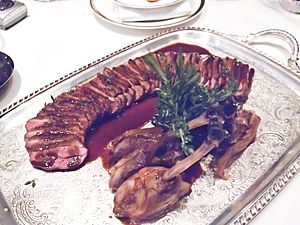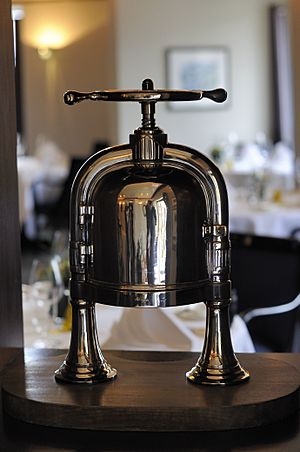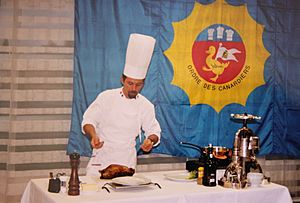Pressed duck facts for kids
Pressed duck (also known as French: canard à la presse or French: canard au sang) is a very old and special French dish. It comes from France and is known for being quite fancy.
This unique dish is a specialty from the city of Rouen. People say an innkeeper from a nearby town called Duclair first created it. Since the 1800s, it has also been a famous dish at the Tour d'Argent restaurant in Paris. There, it is called the Caneton Tour d'Argent.
Pressed duck uses different parts of a duck. These parts are served with a sauce made from the duck's own blood and bone marrow. These ingredients are squeezed out using a special machine called a press. Many people consider pressed duck to be a very elegant and important part of French cuisine.
How is Pressed Duck Made?
To make pressed duck, a young, plump duck is chosen first. The duck is humanely killed in a way that keeps its blood inside its body. Then, the duck is partly roasted in an oven.
Next, the duck's liver is ground up and seasoned with spices. The legs and breast meat are carefully removed from the duck.
The rest of the duck's body, including bones, skin, and any remaining meat, is then placed into a special press. This press looks a bit like a wine press. Pressure is applied to squeeze out the duck's blood and other juices from the carcass.
The liquid squeezed from the press is then used to make the sauce. It is thickened and flavored with the ground duck liver, butter, and a type of brandy called Cognac. Finally, the duck breast is added to this sauce to finish cooking.
Making the Special Sauce
Other ingredients can be added to the sauce to make it even richer. These might include foie gras (a rich duck liver paste), port wine, Madeira wine, and lemon juice.
Once the sauce is ready, the duck breast is sliced. It is then served with the sauce as the first part of the meal. The duck legs are usually grilled separately. They are then served as a second course.
See also
- In Spanish: Pato prensado para niños




